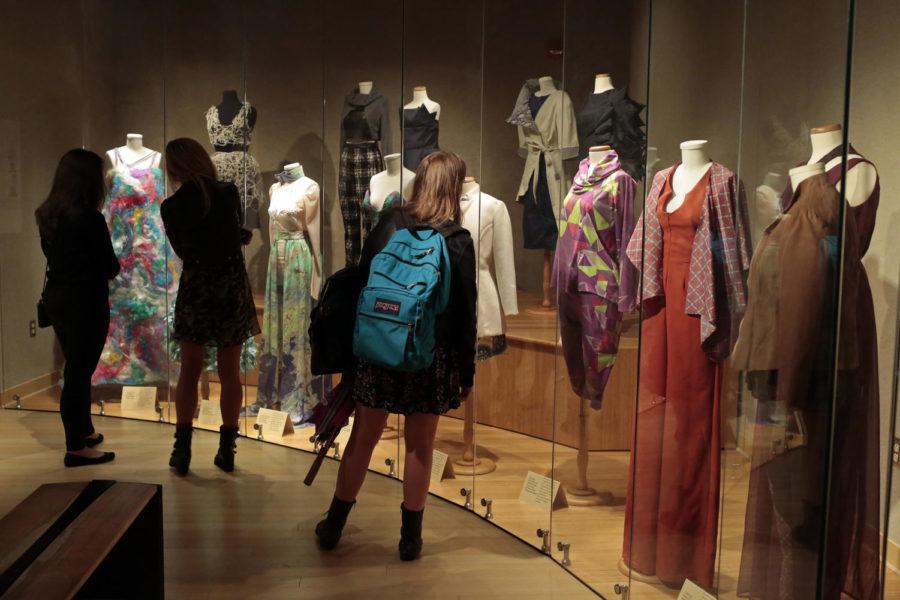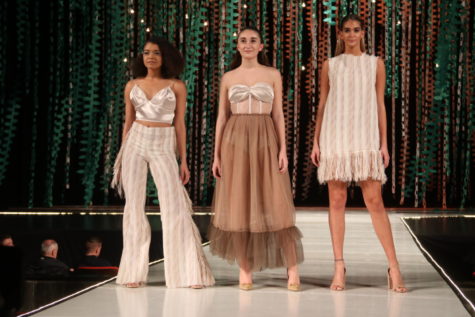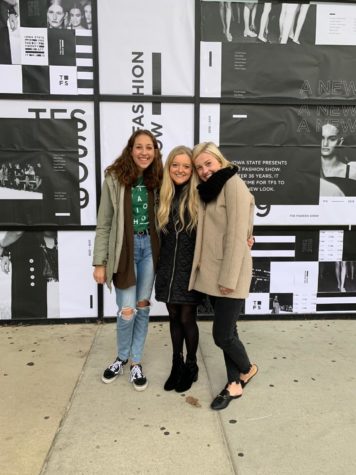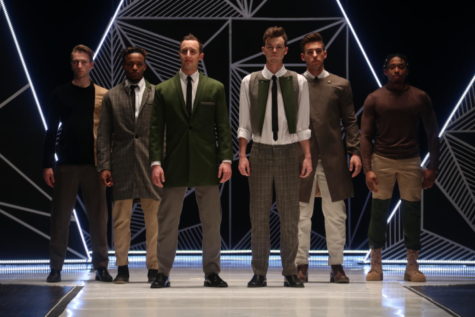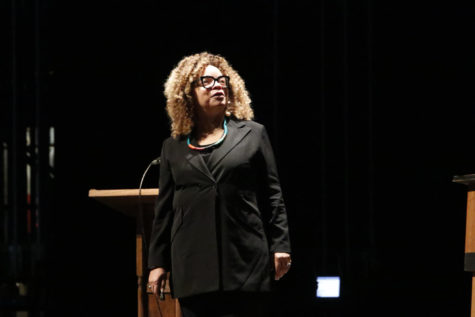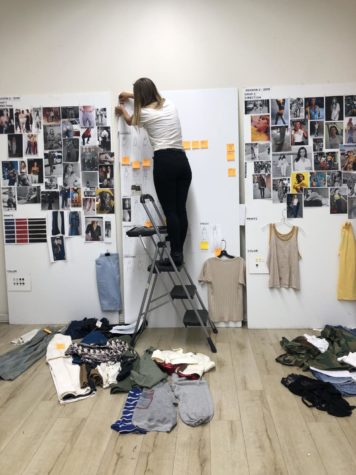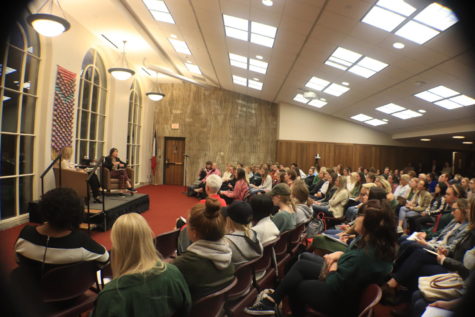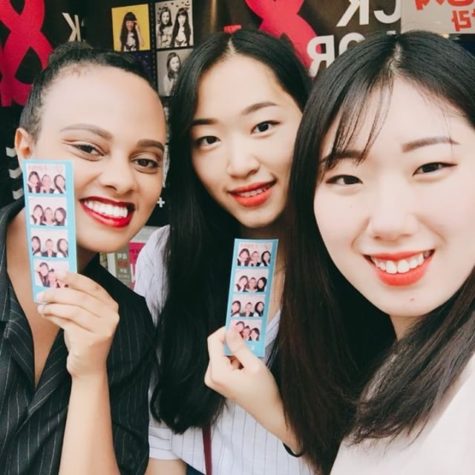Textiles, Clothing Museum serves as teaching tool for students
Brian Achenbach/Iowa State Daily
Students view the current exhibit in the Mary Alice Gallery, “Winning Designs from The Fashion Show 2014,” inside Morrill Hall on April 28.
May 5, 2014
A little boy’s jacket from China made of vibrant-colored fabric with symbols of “good luck” and “a long life” lies flat in a tan metal drawer. The drawer is one of hundreds in a storage room kept at a constant 70 degrees in LeBaron Hall.
This mid-20th century garment tells the story of a child from a privileged Chinese family, a child celebrated for being male and carrying on the family name.
“We look at it as a physical representation of how people dress, but at the same time, there’s just so much more embedded in it in terms of the meaning and gender roles,” said Janet Fitzpatrick, interim curator and collection manager of Iowa State’s Textiles and Clothing Museum.
The museum, located in Morrill Hall, was started in 1923 by Olive Settles, a former ISU faculty member.
“She would go and do research abroad in other countries and collect these examples and bring them back for teaching,” Fitzpatrick said.
After Settles’ death in 1962, the collection was donated to the Textiles and Clothing Museum to be used as a teaching tool at the university.
Today, the collection holds around 9,500 garments, which include various apparel items, from bridal gowns to quilts, and paper patterns.
“This collection really is a teaching collection,” Fitzpatrick said. “We use it in classes — in the history of dress classes. We use it in the cultural perspectives class, but also it’s been used in illustration classes.”
Amanda Lensch, lecturer in apparel, events and hospitality management, has worked with the Textiles and Clothing Museum since her time as an undergraduate student at Iowa State. She now works in the museum, in addition to teaching classes on campus.
Lensch said from her experience she thinks the Textiles and Clothing Museum is a great resource for students in the apparel, merchandising, and design program.
“Objects from the collection are pulled and shown in class, or carefully used as part of an in-class activity,” Lensch said. “This allows the students to see American shirtwaists from the early 1900s, Halston pieces from the 1970s, Kimonos from Japan or Molas from Central America up close and personal.”
Jennifer Gordon, graduate research assistant in apparel, events and hospitality management said she is passionate about the benefits of learning from objects.
“Anyone who is interested in researching and learning from objects in the museum collection can do so under supervision and by appointment,” Gordon said.
Gordon explained that it is a part of the Textiles and Clothing Museum’s mission to be accessible when it comes to textiles and clothing, as well as other related disciplines.
“Artifacts can help provide students with a better understanding of the time periods in which they were produced,” Gordon said. “The process of examining an object can also help students to think critically, as well as provide them with a jumping off point for further research.”
In addition to benefiting apparel, merchandising, and design students, Lensch said there are benefits for those not in the program as well.
“We can be a great resource for those who are interested in fashion, or art and design or even history,” Lensch said.
Those who study economics or business can learn from the museum too. Lensch said the textile industry was one of the first industries in the United States, as well as being one of largest, which has impacted the way business is done today.
“Fashion, or the study of dress, can simply be a lens for how you look at whatever you are interested in,” Lensch said. “There is so much more to it than you might think. The exhibits in the Mary Alice Gallery just give you a glimpse into the infinite possibilities that exist within the Textiles and Clothing Museum.”
Fitzpatrick said the museum obtains pieces for the collection from faculty members, students who study abroad, international students, alumni and other people in the Ames community. The Textiles and Clothing Museum recently acquired 42 textiles from West Sumatra that were donated by an alumna of the apparel program.
“They are called ‘songket,’” Fitzpatrick said. “They’re woven textiles but they have real metallic thread woven through them, so they are sparkly and kind of shiny — and they’re heavy because it’s real gold, real silver threads in there.”
Fitzpatrick said these new pieces are ones that are unlike others in the collection from the same geographical area and she said those working with the museum are excited to have them in the collection.
“We have a process that we go through if somebody has something they want to offer to us,” Fitzpatrick said. “We ask first for photographs, condition and anything that they know about the history of the garment because we can’t take everything.”
Fitzpatrick explained that items that take priority when it comes to being accepted into the Textiles and Clothing Museum are those with Iowa provenance.
“Our story is about Iowa,” Fitzpatrick said. “We can’t collect from all across the country, and it doesn’t make sense to.”
With over 9,000 pieces, Fitzpatrick said those who work for the museum have been deaccessioning, which she said involves eliminating duplicates in the collection.
“That’s part of a process we have being going through to make room for more in our storage because our storage is really full already and we want to be actively collecting even contemporary fashion,” Fitzpatrick said.
She explained that while it is great for vintage apparel to be donated, she is thinking proactively.
“We want to be able to provide the story of what was going on in 2014 so that, 50 years from now, they have something and they’re not getting something that’s all beat up and secondhand,” Fitzpatrick said. “To document the dress of a time period is really challenging.”
Documenting dress is not the only challenge Fitzpatrick and the Textiles and Clothing Museum face. Fitzpatrick said preserving the museum’s textiles largely depends on how the pieces are stored.
“That’s the nature of textiles,” Fitzpatrick said. “They’re not meant to last forever, and so we just do our best to preserve things as they come to us and try not to do any more damage to them than they already have.”
Fitzpatrick said when a person is not using a museum workspace, the lights are turned out and humidity and temperature levels are monitored in order to preserve the collection properly. She said it is also important to make sure insects are not able to get to the textiles.
The Mary Alice Gallery’s current exhibit, “Winning Designs from the Fashion Show 2014,” will be open to the public until August 29.
“The fashion world today is influenced by a myriad of things, culture and history being a part of that. We like to show our aspiring designers and merchandisers a little piece of that history,” Lensch said. “Who knows? Maybe it will influence them in some way.”

